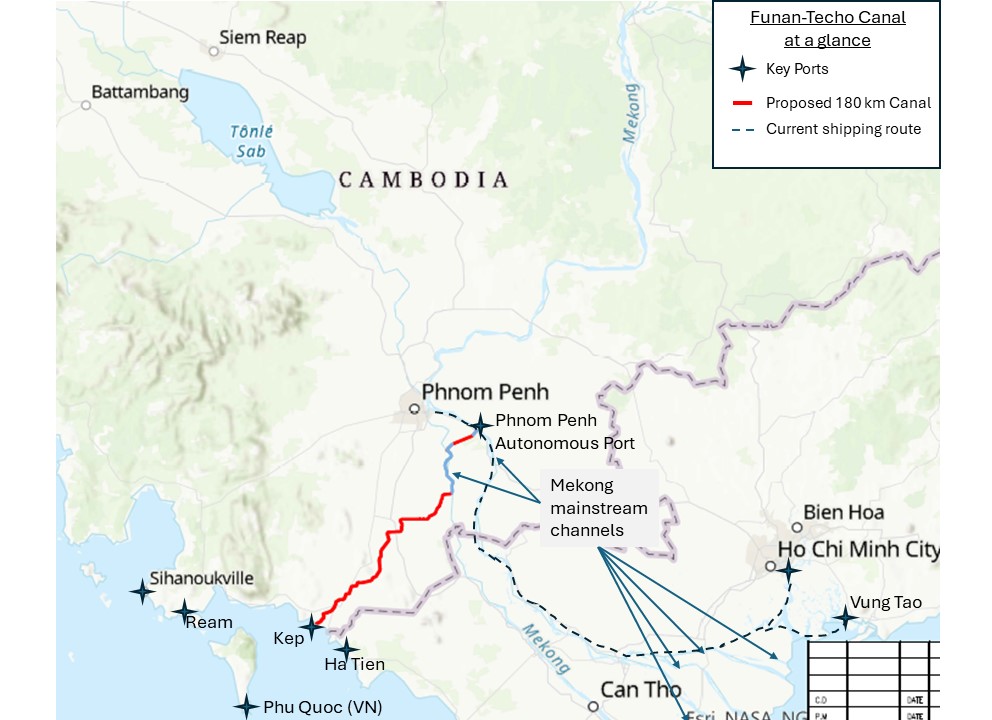India/China too.
From/via the RAND Corporation, September 3, 2024:
This commentary was originally published by Nikkei Asia on September 2, 2024.
While geopolitical tensions between China and the United States have soared in the South China Sea and Taiwan Strait, raising serious fears of war, another important body of water in the Indo-Pacific—the Gulf of Thailand—has heretofore remained relatively calm. That may be set to change in the coming years as Beijing embarks on a series of controversial projects that could inflame the region.
On August 5, Cambodian Prime Minister Hun Manet presided over a ceremony to launch the construction of the Funan-Techo Canal project, connecting the landlocked capital, Phnom Penh, to the Gulf of Thailand. If successfully completed, the canal will cut shipping transits through neighboring Vietnam by 70 percent and boost government revenue by $88 million annually to support Cambodia's socio-economic development. At the ceremony, Manet noted “through the construction of the historic canal, we are showing a sense of patriotism and national unity.”
But Cambodian interests clearly are not the only national interests in play. China is funding the $1.7 billion project, and it is set to benefit geostrategically. For the first time, the canal will grant Beijing access to the Gulf of Thailand directly from China. Because the Mekong River originates in China's Tibetan province, Beijing could sail not just commercial ships, but warships, through Myanmar, Thailand, Laos, and Cambodia, and then through the completed Funan-Techo canal and into the Gulf of Thailand. To be sure, there are good reasons to believe Beijing would struggle to navigate the new canal with its military, to include the numerous Chinese damming projects along the Mekong and the likely reduced water level and flow because of them, as well as the need to blast rapids for deeper draft ships.
But none of these challenges are necessarily insurmountable over the longer term. This means that China's maritime forces—whether navy, coast guard, or fishing militia—could leverage their newfound riverine presence to deploy into the region with three key objectives in mind.
First, Beijing might try to blunt Washington's uninhibited access to the Strait of Malacca. China's so-called “Malacca Dilemma” posits that the U.S. military might close off this critical strait connecting the Indian and Pacific oceans, thereby choking Beijing off from resources needed to prosecute conflicts over Taiwan or in the South China Sea.
A second advantage of the canal project is that it would obviate the need for Chinese maritime forces to sail through the South China Sea and around Indochina to access the Gulf of Thailand. This would not only be quicker but would also limit the chances of adversary forces challenging Chinese deployments.
And finally, the canal would allow China to establish a presence on Vietnam's western flank rather than just to its east in the South China Sea. This could literally be a geostrategic gamechanger as it would reduce the value of Cam Ranh Bay naval base on Vietnam's southeast shoreline as well as Hanoi's recently built artificial islands in the South China Sea. It would also force Vietnam to make difficult decisions about the allocation of military resources to address the new potential theater to its west....
....MUCH MORE
Previously:
April 2024 - "Cambodia getting a China-backed, game-changing canal"
August 2024 - Maybe Singapore Won't Be Bypassed: "Thailand's 'land bridge' ambitions face fresh roadblocks"
And related, from Reuters, April 6:
China holds military drills at newly expanded Cambodian naval base
And from The Straits Times, April 19:
Japanese warships dock at Cambodia's Chinese-renovated naval base
The base at Ream is just up the coast from the canal's oceanic endpoint:

Currently China's only overseas base is on the other side of the Indian Ocean at Djibouti:
You Knew China Had A Base At The Approaches To The Red Sea, Right? "...Chinese, Iranian and Indian Warships Are Now in the Red Sea, Gulf of Aden"I've been meaning to post something on that addition to the chokepoints the Peoples Liberation Army (Navy) overlooks* but every time I approach the keyboard, K.C. and the Sunshine Band fires up with Sheikh, Sheikh, Sheikh, Sheikh, Sheikh, Sheikh, Sheikh, Djibouti, Sheikh Djibouti.
(I am so sorry)